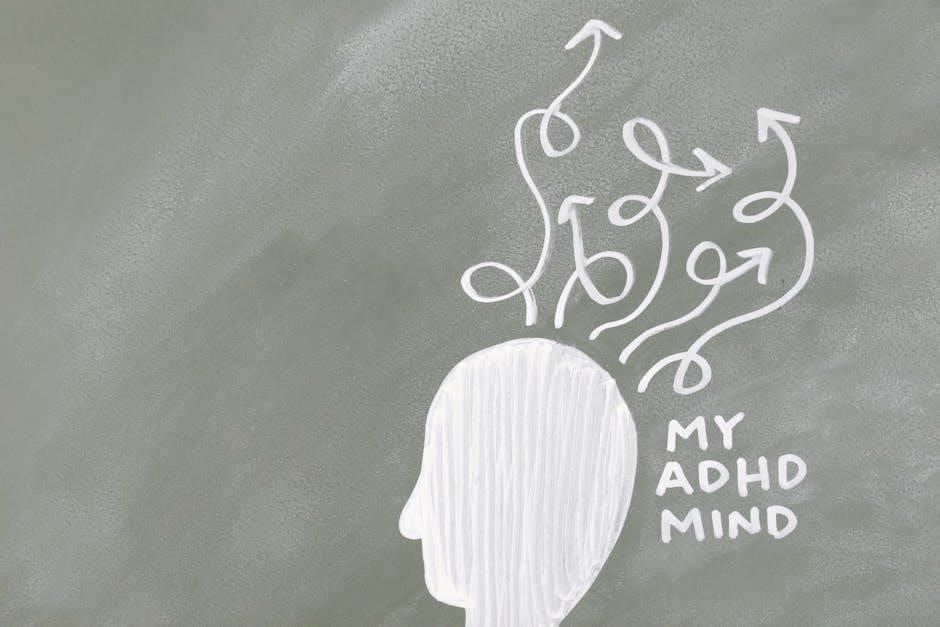Section 504 of the Rehabilitation Act of 1973 ensures students with disabilities‚ including ADHD‚ receive equal access to education through tailored accommodations.
1.1 Overview of Section 504 and Its Application to ADHD
Section 504 is a civil rights law ensuring students with disabilities‚ including ADHD‚ receive equal access to education. It mandates reasonable accommodations to address specific needs‚ fostering an inclusive learning environment. Unlike an IEP‚ Section 504 plans focus on accessibility and support rather than specialized instruction‚ making it a vital tool for students with ADHD.
1.2 Importance of Accommodations for Students with ADHD
Accommodations under Section 504 are crucial for students with ADHD‚ addressing challenges like inattention‚ impulsivity‚ and disorganization. These supports level the playing field‚ enabling students to access learning equally. By providing tailored strategies‚ accommodations help improve focus‚ behavior‚ and academic performance‚ fostering confidence and success in school.

Eligibility Criteria for 504 Plans
Eligibility for a 504 plan requires a student’s disability‚ such as ADHD‚ to substantially limit a major life activity‚ ensuring access to appropriate educational accommodations.
2.1 Understanding Disability Under Section 504
Section 504 defines a disability as a physical or mental impairment that substantially limits one or more major life activities. For ADHD‚ this may include challenges with learning‚ focusing‚ or social interactions. The impairment must significantly impact the student’s ability to participate in education‚ ensuring eligibility for accommodations under the plan.
2.2 How ADHD Qualifies as a Disability
ADHD qualifies as a disability under Section 504 if it substantially limits one or more major life activities‚ such as learning‚ focusing‚ or social interactions. Symptoms like inattention‚ hyperactivity‚ or impulsivity must significantly impact the student’s ability to participate in educational programs. Documentation of these challenges ensures eligibility for accommodations tailored to address specific needs.

Common 504 Accommodations for ADHD
Common 504 accommodations for ADHD include preferential seating‚ movement breaks‚ and assistive technology. These strategies help students stay focused‚ organized‚ and engaged in their learning environment.
3.1 Classroom Accommodations
Classroom accommodations for ADHD often include preferential seating‚ such as placing the student near the teacher or away from distractions. Minimizing stimulating environments and seating near positive role models can also help. Additionally‚ providing a quiet space or sensory room for breaks allows students to refocus. These adjustments create a supportive learning environment tailored to individual needs.
3.2 Academic Accommodations
Academic accommodations for ADHD may include extended time to complete assignments‚ breaking tasks into smaller steps‚ and providing graphic organizers to enhance organization. Allowing the use of assistive technology‚ such as voice-recognition software or word processors‚ can also support writing tasks. These adjustments help students manage academic challenges and ensure they can demonstrate their knowledge effectively.
3.3 Behavioral Accommodations
Behavioral accommodations for ADHD focus on managing impulsivity and hyperactivity. Strategies include preferential seating near the teacher‚ positive role models‚ and non-verbal signals to refocus attention. Additional supports may involve frequent check-ins‚ visual reminders of classroom expectations‚ and structured behavioral interventions. These accommodations help students regulate behavior‚ stay on task‚ and meet classroom expectations without punitive measures.
3.4 Environmental Accommodations
Environmental accommodations for ADHD often involve creating a distraction-free learning space. Students may benefit from seating near the teacher or in a quiet area‚ access to sensory rooms‚ and reduced classroom noise. Additionally‚ providing a clutter-free workspace and using natural light can help minimize sensory overload‚ fostering a more focused and productive learning environment tailored to individual needs.

Creating an Effective 504 Plan
A well-crafted 504 plan involves collaboration between teachers‚ parents‚ and students to tailor accommodations addressing ADHD-related challenges‚ ensuring a personalized approach to support academic success.
4.1 Steps to Develop a Tailored 504 Plan
Developing a tailored 504 plan begins with identifying the student’s specific needs through evaluations and input from parents‚ teachers‚ and the student. The team collaborates to outline accommodations‚ such as preferential seating or extended time‚ ensuring they address ADHD-related challenges. The plan is then implemented‚ monitored‚ and adjusted regularly to ensure effectiveness and continued support for the student’s success.
4.2 Collaborating with Teachers and Parents
Collaboration between teachers‚ parents‚ and the student is key to implementing a 504 plan effectively. Teachers provide insights into classroom needs‚ while parents share observations of the student’s behavior at home. Regular communication ensures consistency in applying accommodations like preferential seating or movement breaks. Training and resources for teachers‚ along with parental involvement in progress monitoring‚ foster a supportive environment tailored to the student’s success.

Role of Teachers in Implementing 504 Accommodations
Teachers play a vital role in implementing 504 accommodations by creating structured environments‚ using behavioral strategies‚ and providing necessary tools to monitor and support student progress effectively.
5.1 Strategies for Classroom Management
Effective classroom management for students with ADHD includes preferential seating‚ minimizing distractions‚ and providing movement breaks. Teachers can use visual reminders‚ positive reinforcement‚ and clear expectations to maintain focus. Breaking tasks into smaller steps and offering frequent check-ins also helps. These strategies create a structured environment that supports academic engagement and reduces disruptive behaviors‚ fostering a positive learning atmosphere for all students.
5.2 Tools and Resources for Teachers
Teachers can utilize tools like graphic organizers for lesson planning‚ assistive technology such as text-to-speech software‚ and behavior tracking apps to monitor progress. Positive reinforcement tools‚ such as reward charts‚ and sensory aids like fidget toys also support students with ADHD. These resources help teachers create a structured and inclusive learning environment‚ addressing both academic and behavioral needs effectively.

Differences Between 504 Plans and IEPs
IEPs are for students needing specialized instruction under IDEA‚ while 504 plans provide accommodations for students with disabilities under Section 504‚ covering broader needs without requiring specialized education.
6.1 Understanding the Legal and Practical Distinctions
Section 504 plans and IEPs differ legally and practically. IEPs‚ under IDEA‚ require specialized instruction for students with disabilities‚ while 504 plans provide accommodations under Section 504 for broader disabilities‚ including ADHD. IEPs involve detailed goals and progress monitoring‚ whereas 504 plans focus on equal access and may include less formal documentation‚ addressing needs without requiring specialized education.
6.2 When to Choose a 504 Plan Over an IEP
A 504 plan is preferred when a student with ADHD requires accommodations for equal access but does not need specialized instruction. Unlike an IEP‚ it’s ideal for students who can succeed in general education with supports like preferential seating or extended time‚ without needing intensive academic or behavioral interventions typically outlined in an IEP.
Legal Rights and Protections for Students with ADHD
Section 504 of the Rehabilitation Act and the ADA protect students with ADHD from discrimination‚ ensuring equal access to education. These laws require schools to provide reasonable accommodations to meet individual needs‚ fostering an inclusive learning environment and safeguarding students’ rights to participate fully in educational programs.
7.1 Overview of Legal Protections Under Section 504
Section 504 prohibits discrimination against individuals with disabilities‚ ensuring equal access to education. ADHD is recognized as a disability under this law‚ requiring schools to provide necessary accommodations. These protections apply to all school-related activities‚ ensuring students with ADHD can fully participate. Schools must comply‚ or they may face legal consequences for failing to uphold these rights.
7.2 Ensuring Compliance and Enforcement
Schools must enforce Section 504 protections by developing and implementing valid 504 plans for ADHD students. Parents can request evaluations and dispute decisions through formal grievance processes. The Office for Civil Rights (OCR) investigates non-compliance‚ ensuring schools provide required accommodations. Regular monitoring and updates to the plan ensure ongoing support and adherence to legal standards‚ safeguarding student rights effectively.

Implementing and Monitoring Accommodations
Effective implementation and monitoring of 504 accommodations for ADHD involve regular check-ins and adjustments to ensure student success. Strategies include preferential seating‚ movement breaks‚ and assistive technology.
8.1 Putting the Plan into Action
Implementing a 504 plan involves collaboration between teachers‚ parents‚ and students. Strategies include preferential seating‚ movement breaks‚ and assistive technology. Regular communication ensures accommodations are consistently applied. Teachers adapt instruction to meet individual needs‚ while parents monitor progress and provide feedback. This collaborative approach fosters a supportive learning environment tailored to the student’s ADHD requirements.
8.2 Regular Monitoring and Adjustments
Regular monitoring ensures the 504 plan remains effective. Progress is tracked through teacher observations‚ student feedback‚ and parent input. Adjustments are made based on what works and what doesn’t. This continuous process involves reviewing accommodations‚ updating strategies‚ and documenting outcomes. Ongoing collaboration between parents‚ teachers‚ and students ensures the plan evolves to meet changing needs and promotes long-term success for students with ADHD.

Additional Resources and Support
Explore comprehensive checklists‚ guides‚ and websites offering detailed information on 504 accommodations. Connect with ADHD support groups and organizations for additional tools and strategies to enhance academic success.
9.1 Accessing Further Information and Tools
Utilize online resources‚ such as PDF guides and checklists‚ to explore detailed 504 accommodations for ADHD. Websites like ed.gov and advocacy organizations offer comprehensive tools‚ sample plans‚ and legal insights to support students effectively. These resources provide practical strategies and legal frameworks to ensure compliance and optimal support for students with ADHD.
9.2 Connecting with Support Groups and Organizations
Joining support groups and organizations‚ such as CHADD or ADDA‚ provides valuable resources and community connections for families and educators. These groups offer workshops‚ webinars‚ and downloadable guides to help navigate 504 accommodations for ADHD. They also facilitate sharing of strategies and best practices‚ ensuring students receive comprehensive support tailored to their needs.
Section 504 accommodations provide effective support for students with ADHD‚ addressing challenges in focus‚ organization‚ and behavior‚ while fostering academic success and inclusivity.
10.1 Summary of Key Points
Section 504 accommodations for ADHD provide tailored support to ensure students with ADHD have equal access to education. These accommodations address challenges in focus‚ organization‚ and behavior‚ offering strategies like preferential seating‚ extended time‚ and behavioral interventions. By implementing these supports‚ schools create an inclusive environment that fosters academic success and equity for students with ADHD.
10.2 Final Thoughts on Supporting Students with ADHD
Supporting students with ADHD requires a collaborative effort between parents‚ educators‚ and support staff. By tailoring accommodations to individual needs‚ schools empower students to thrive academically and socially. Fostering resilience and providing consistent support ensures students with ADHD can reach their full potential and succeed in an inclusive educational environment.

Leave a Reply
You must be logged in to post a comment.